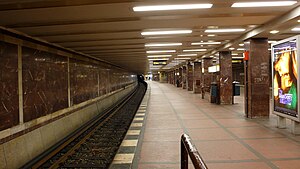
Mohrenstraße (Berlin U-Bahn)
 Platform | |||||||||||
| General information | |||||||||||
| Location | Mohrenstraße/Wilhelmstraße Mitte, Berlin Germany | ||||||||||
| Coordinates | 52°30′42″N 13°23′05″E / 52.51167°N 13.38472°E | ||||||||||
| Owned by | Berliner Verkehrsbetriebe | ||||||||||
| Operated by | Berliner Verkehrsbetriebe | ||||||||||
| Platforms | 1 island platform | ||||||||||
| Tracks | 2 | ||||||||||
| Connections | |||||||||||
| Construction | |||||||||||
| Structure type | Underground | ||||||||||
| Bicycle facilities | Yes (Call a Bike, bicycle parking) | ||||||||||
| Accessible | Yes | ||||||||||
| Other information | |||||||||||
| Fare zone | |||||||||||
| History | |||||||||||
| Opened | 1 October 1908 | ||||||||||
| Services | |||||||||||
| |||||||||||
 | |||||||||||
| |||||||||||
Mohrenstraße is a Berlin U-Bahn station on line U2, located in the district of Mitte.

The station is located at the western end of the eponymous Mohrenstraße, which runs in an east-west direction. Its western entrance opens up to the north-south crossing Wilhelmstraße and is located opposite the junction with Voßstraße. The east entrance is located at Glinkastraße.

History
The original station designed by Alfred Grenander opened on 1 October 1908 on the new branch from Potsdamer Platz to Spittelmarkt. It was then called Kaiserhof after the nearby grand hotel on the Wilhelmplatz square, was designated by black and white at platform level, and had an oval opening to the stairs and a booking hall with elaborate tilework at the Wilhelmstraße end. This entrance was rebuilt in 1936, the year of the Berlin Olympics, to provide more space for parades at the adjacent Reich Chancellery.[2] The station was severely damaged in World War II on 3 February 1945.[3]

The rebuilt station, now located in East Berlin, reopened on 18 August 1950 as Thälmannplatz, to which the Wilhelmplatz square had been renamed for the communist leader Ernst Thälmann.[2] The interior was lined with marble, which was long believed to have been taken from Hitler's New Reich Chancellery. However, according to the East Berlin newspapers Neues Deutschland and Berliner Zeitung from 19 August 1950, the marble for the station was delivered directly from quarries in Thuringia.[4] In more recent times, petrographic research confirmed this origin of the material.[4][5]

With the erection of the Berlin Wall from 13 August 1961, the line ceased to run between East and West Berlin and the station became the terminus of the line in East Berlin. Beginning in 1986 the square was overbuilt[2] by a housing estate and the Czechoslovakian Embassy, and on 15 April 1986 the station was renamed Otto-Grotewohl-Straße, the name of Wilhelmstraße at that time, after the politician Otto Grotewohl.

On 3 October 1991, following German reunification, the station was renamed again to Mohrenstraße.[2] The line was reconnected on 13 November 1993 and simultaneously reconfigured, forming a new U2 line between Vinetastraße in the east and Ruhleben in the west.

Since the 1990s, some have criticized Mohrenstraße (literally: "Street of the Moors", but Mohr is in people mostly understood as black African) as being a racist street and station name.[6] The murder of George Floyd prompted anti-racist demonstrations and accompanying debates about structural racism in Germany; in response to this, the Berliner Verkehrsbetriebe (BVG) announced on 3 July 2020 that they would change the station name from Mohrenstraße to Glinkastraße,[7] after the street name at the station's eastern entrance, which honors the 19th-century Russian composer Mikhail Ivanovich Glinka. This name was similarly criticised because Glinka had expressed antisemitic views, and the BVG said a final decision on the new name had yet to be made.[8][9][10] Additionally, the proposed new name was said to be likely to cause people to think of the other, Unter den Linden, end of Glinkastraße.[8] On 20 August, 2020, the District Assembly of Berlin-Mitte voted that Mohrenstraße will be renamed "Anton-Wilhelm-Amo-Straße".

References
- ^ "Alle Zielorte". Verkehrsverbund Berlin-Brandenburg. 1 January 2021. p. 64. Retrieved 5 May 2021.
- ^ a b c d "U2: Die Spittelmarktlinie". Berliner Untergrundbahn.de (in German). Archived from the original on 18 September 2016.
- ^ "Die U-Bahn im 2. Weltkrieg". Berliner Untergrundbahn.de (in German). Archived from the original on 20 August 2010.
- ^ a b Mittig, Hans-Ernst (2005). "Marmor der Reichskanzlei" [Marble of the Reich chancellery] (PDF). In Bingen, Dieter; Hinz, Hans-Martin (eds.). Die Schleifung. Zerstörung und Wiederaufbau historischer Bauten in Deutschland und Polen [The Razing: Destruction and Reconstruction of Historical Buildings in Germany and Poland] (in German). Wiesbaden: Harrasowitz. pp. 174–87. ISBN 3-447-05096-9.
- ^ Mauruszat, Axel; Topel, Klaus (2008). "Marmor-Mythos Mohrenstraße". Verkehrsgeschichtliche Blätter (in German). 4: 106–09.
- ^ Schließ, Gero (15 July 2017). "Berlin 24/7: Does Berlin have racist street names?" (opinion). Deutsche Welle.
- ^ Camino Gonzalez, Jenipher (3 July 2020). "Berlin metro station to be renamed after pushback over racist term". Deutsche Welle.
- ^ a b "Abstecher zum Nordkoreaner und zu einer jüdischen Verschwörung" [Detour to the North Koreans and a Jewish conspiracy]. Berliner Zeitung (in German). 6 July 2020. Retrieved 18 October 2024.
- ^ Oltermann, Philip (7 July 2020). "What's in a name? Berlin wrestles with past in metro station row". The Guardian.
- ^ "Mohrenstrasse: Berlin farce over renaming of 'racist' station". BBC News. 9 July 2020.
See what we do next...
OR
By submitting your email or phone number, you're giving mschf permission to send you email and/or recurring marketing texts. Data rates may apply. Text stop to cancel, help for help.
Success: You're subscribed now !







